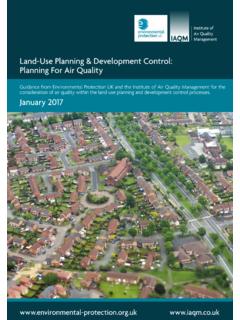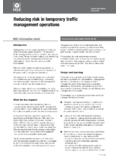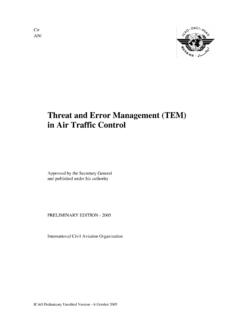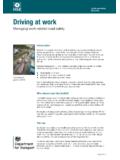Transcription of Guidance Note for Drop Zone Management within …
1 Guidance Note for Drop Zone Published by the victorian Management within the electricity supply industry victorian electricity supply industry February 2016. This Guidance Note has been developed by the victorian electricity supply industry (VESI) Work Practices Committee. DATE VERSION AMENDMENT. NOVEMBER 2015 FIRST DRAFT. Guidance Note for Drop Zone Management within the victorian electricity supply industry UNCONTROLLED WHEN PRINTED Page 1 of 6. CONTENTS. 1 INTRODUCTION .. 3. 2 PURPOSE .. 3. 3 SCOPE .. 3. 4 DROP ZONE GUIDE .. 3. THE RISK .. 3. JOB SAFETY ANALYSIS (JSA) .. 3. DROP ZONE ESTABLISHMENT AND Management .. 4. COMMON CONTROLS .. 5. 5 REFERENCE .. 6. Guidance Note for Drop Zone Management within the victorian electricity supply industry UNCONTROLLED WHEN PRINTED Page 2 of 6. 1 INTRODUCTION.
2 When working at height there is always a possibility of equipment, tools or other materials falling into the worksite below. This risk is managed by establishing a Drop Zone which is an established practice in the VESI and is underpinned by training and a knowledge of working aloft within the victorian electricity supply industry (VESI). A Drop Zone is described as a defined area below work that is being performed above ground, where there is the potential for suspended loads, tools, equipment, waste or other items to fall and create a risk to workers or members of the public. 2 PURPOSE. This guideline details VESI's minimum requirements for the Management of drop zones. 3 SCOPE. This guideline applies to all VESI works performed at height where there is a risk of an object falling a distance greater 4 metres.
3 This is a VESI principle; therefore, consultation should always occur with the Network Owner or its representative to determine if there are other requirements to be considered in association with this practice 4 DROP ZONE GUIDE. THE RISK. Any object dropped from a height creates a significant amount of force. The higher the aerial work being performed, the more force the dropped object will generate. For example, a one kilogram porcelain insulator dropped from nine metres creates about 2700 kilograms of force. Now consider that an 80 kilogram professional boxer throws a punch somewhere between 500 to 800 kilograms of force. That one kilogram insulator is generating two to three times more force than the boxer - it's all about the physics. JOB SAFETY ANALYSIS (JSA). VESI requires that prior to performing any work that all employees complete a JSA referring to the appropriate Work Practices, Procedures and Safe Work Method Statements (SWMS).
4 The 2 high risk activities that would normally be associated falling objects in VESI are: Working at a Height of more than 2 metres and Use of Powered Mobile Plant General controls that will be associated with each Network Owner's documents managing falling objects will be: Confirming all lifting equipment is inspected and within test date prior to use Ensuring SWL of any lifting plant and equipment is not exceeded Establishing a Drop Zone Guidance Note for Drop Zone Management within the victorian electricity supply industry UNCONTROLLED WHEN PRINTED Page 3 of 6. Appointment of a Safety Observer Avoiding working beneath suspended loads where practicable Setting up exclusion zones to indicate the drop zone area In all instances when working aloft a Drop Zone shall be considered and established in line with this guideline DROP ZONE ESTABLISHMENT AND Management .
5 When planning to establish a defined Drop Zone the work should be planned in consideration of the following: Whether the work can be conducted at ground level Size and weight of equipment and materials being used in the elevated work area Height at which the work will be carried out Proximity and volume of pedestrian and vehicle traffic Weather conditions for example: high winds The development of lift plans where required ( for crane work in transmission tower and stations construction environments). When establishing a Drop Zone, the distance a falling object may travel can be easily underestimated. Under-built facilities and other obstructions can cause a dropped object to deflect and travel in an unexpected direction. Where possible it is good practice for a Drop Zone to assume a cone shape and extend in all directions.
6 The establishment and Management of the Drop Zone shall be discussed during the pre-job risk assessment (JSA). Once established, the following practices shall be used to maintain the effectiveness of the Drop Zone: Keeping the Drop Zone clear of workers and the general public while work is occurring overhead or whilst loads are suspended. Stopping overhead activities and ensuring all materials, tools and equipment are positively controlled if there is an unavoidable need for a crew member to enter the Drop Zone. Exercising positive control anytime that tools, materials and equipment are being moved from the ground or bucket. Tool bags and handlines are the only way to ensure that the tools or material will safely arrive where you need them. Guidance Note for Drop Zone Management within the victorian electricity supply industry UNCONTROLLED WHEN PRINTED Page 4 of 6.
7 Situation awareness and good verbal and visual communication with those aloft to ensure crew members below are clear of potential injury threats. Witches hats, bollards, barriers, chains or ropes can be put in place to reduce un- intended or unauthorised entry by the work crew and members of the public. As a rule of thumb when the working height is less than 20m the Drop Zone radius should be approximately one third (33)% of the working height. However as a general rule, a minimum Drop Zone radius of 4m should be established (where practicable). For a working height of 20m or more the Drop Zone radius should be approximately one quarter (25%) of the working height where practicable. Where this is not feasible due to the proximity of surrounding structures or buildings, the Drop Zone shall be as large as possible with the primary focus being to protect those persons on the ground.
8 Where a neighbouring property or work space falls within the area that would normally be a Drop Zone, there should be liaison with any affected persons prior to works commencing. Table 1 provides Guidance on the minimum drop zone radius that may be applied: Table 1. Working Height (a) Drop Zone Radius (b) Working Height (a) Drop Zone Radius (b). < 12m 4m 25 m 6m 14 m 5m 30 m m 16 m m 40 m 10 m 18 m 6m 50 m m 20 m 6m 75 m 19 m COMMON CONTROLS. Table 2 below provides examples of Drop Zone control measures as a general Guidance for common work types. These controls are to be used in conjunction with the practices described in section Guidance Note for Drop Zone Management within the victorian electricity supply industry UNCONTROLLED WHEN PRINTED Page 5 of 6. Table 2. Scenario Example Drop Zone Common Controls Distribution pole hardware replacement or maintenance that is away from public areas Drop Zone delineated with traffic cones including roadways.
9 Replacing a cross arm on a pole in a paddock or reserve Distribution pole hardware replacement or maintenance that is in public areas including Traffic Management to prevent or control vehicle roadways. replacing a cross arm on a entry into the Drop Zone; and pole on the roadside Closure of pathways and pedestrian detour to keep pedestrians out of Drop Zone; and The use of barriers (as opposed to cones alone) to clearly define and restrict entry to the Drop Zone Distribution Re-conductoring Supervision/observation to prevent entry beneath conductors when pulled and strained Transmission tower and line work that is away from public areas including roadways Drop Zone delineated with traffic cones; or Use of existing barriers where established for step &. touch potential (where appropriate). Transmission tower and line work that is in public areas including roadways.
10 Traffic Management to prevent or control vehicle replacing an insulator string on a pole on the entry into Drop Zone; and roadside Closure of pathways and pedestrian detour to keep pedestrians out of Drop Zone; and The use of barriers to clearly define and restrict entry to the Drop Zone; or Use of existing barriers where established for step & touch potential (where appropriate). Station Maintenance work Use of existing delineation to determine Drop Zones ( permit area barriers/ chains) or Drop Zone delineated with traffic cones 5 REFERENCE. Safe Work Australia Falling Objects Fact Sheet Guidance Note for Drop Zone Management within the victorian electricity supply industry UNCONTROLLED WHEN PRINTED Page 6 of 6.




